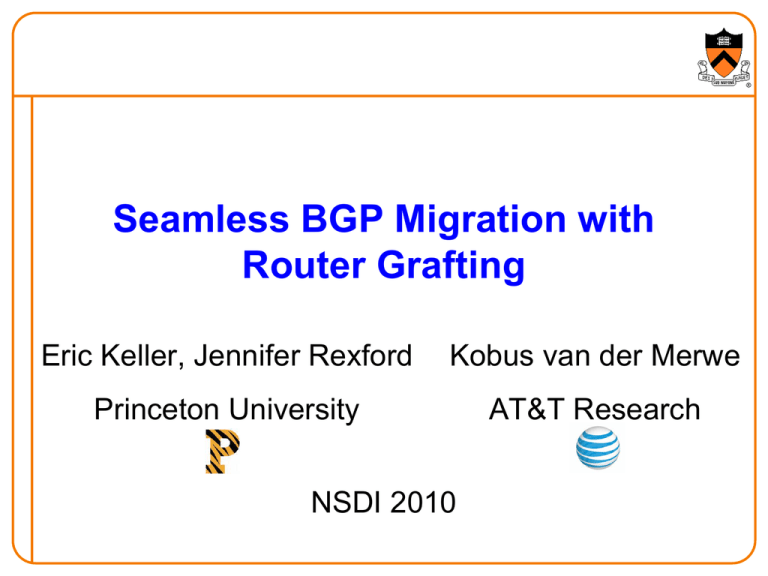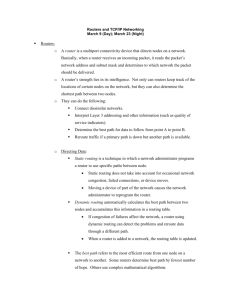Seamless BGP Migration with Router Grafting Eric Keller, Jennifer Rexford
advertisement

Seamless BGP Migration with Router Grafting Eric Keller, Jennifer Rexford Kobus van der Merwe Princeton University AT&T Research NSDI 2010 Dealing with Change • Networks need to be highly reliable – To avoid service disruptions • Operators need to deal with change – Install, maintain, upgrade, or decommission equipment – Deploy new services – Manage resource usage (CPU, bandwidth) • But… change causes disruption – Forcing a tradeoff 2 Why is Change so Hard? • Root cause is the monolithic view of a router (Hardware, software, and links as one entity) 3 Why is Change so Hard? • Root cause is the monolithic view of a router (Hardware, software, and links as one entity) Revisit the design to make dealing with change easier 4 Our Approach: Grafting • In nature: take from one, merge into another – Plants, skin, tissue • Router Grafting – To break the monolithic view – Focus on moving link (and corresponding BGP session) 5 Why Move Links? 6 Planned Maintenance • Shut down router to… – Replace power supply – Upgrade to new model – Contract network • Add router to… – Expand network 7 Planned Maintenance • Could migrate links to other routers – Away from router being shutdown, or – To router being added (or brought back up) 8 Customer Requests a Feature Network has mixture of routers from different vendors * Rehome customer to router with needed feature 9 Traffic Management Typical traffic engineering: * adjust routing protocol parameters based on traffic Congested link 10 Traffic Management Instead… * Rehome customer to change traffic matrix 11 Understanding the Disruption (today) 1) Reconfigure old router, remove old link 2) Add new link link, configure new router 3) Establish new BGP session (exchange routes) delete neighbor 1.2.3.4 Add neighbor 1.2.3.4 12 Understanding the Disruption (today) 1) Reconfigure old router, remove old link 2) Add new link link, configure new router 3) Establish new BGP session (exchange routes) Downtime (Minutes) 13 Router Grafting: Breaking up the router Send state Move link 14 Router Grafting: Breaking up the router Router Grafting enables this breaking apart a router (splitting/merging). 15 Not Just State Transfer Migrate session AS300 AS100 AS200 AS400 16 Not Just State Transfer Migrate session AS300 AS100 AS200 AS400 The topology changes (Need to re-run decision processes) 17 Goals • Routing and forwarding should not be disrupted – Data packets are not dropped – Routing protocol adjacencies do not go down – All route announcements are received • Change should be transparent – Neighboring routers/operators should not be involved – Redesign the routers not the protocols 18 Challenge: Protocol Layers B A BGP TCP IP Exchange routes BGP Deliver reliable stream Send packets IP Migrate State Physical Link Migrate Link TCP C 19 Physical Link B A BGP TCP IP Exchange routes BGP Deliver reliable stream Send packets IP Migrate State Physical Link Migrate Link TCP C 20 Physical Link • Unplugging cable would be disruptive Migrate-from Remote end-point Migrate-to 21 Physical Link • Unplugging cable would be disruptive • Links are not physical wires – Switchover in nanoseconds Migrate-from Remote end-point mi Migrate-to 22 IP B A BGP TCP IP Exchange routes BGP Deliver reliable stream Send packets IP Migrate State Physical Link Migrate Link TCP C 23 Changing IP Address • IP address is an identifier in BGP • Changing it would require neighbor to reconfigure – Not transparent – Also has impact on TCP (later) 1.1.1.2 Remote end-point Migrate-from 1.1.1.1 mi Migrate-to 24 Re-assign IP Address • IP address not used for global reachability – Can move with BGP session – Neighbor doesn’t have to reconfigure Migrate-from Remote end-point 1.1.1.1 mi 1.1.1.2 Migrate-to 25 TCP B A BGP TCP IP Exchange routes BGP Deliver reliable stream Send packets IP Migrate State Physical Link Migrate Link TCP C 26 Dealing with TCP • TCP sessions are long running in BGP – Killing it implicitly signals the router is down • BGP and TCP extensions as a workaround (not supported on all routers) 27 Migrating TCP Transparently • Capitalize on IP address not changing – To keep it completely transparent • Transfer the TCP session state – Sequence numbers – Packet input/output queue (packets not read/ack’d) app recv() send() TCP(data, seq, …) ack OS TCP(data’, seq’) 28 BGP B A BGP TCP IP Exchange routes BGP Deliver reliable stream Send packets IP Migrate State Physical Link Migrate Link TCP C 29 BGP: What (not) to Migrate • Requirements – Want data packets to be delivered – Want routing adjacencies to remain up • Need – Configuration – Routing information • Do not need (but can have) – State machine – Statistics – Timers • Keeps code modifications to a minimum 30 Routing Information • Could involve remote end-point – Similar exchange as with a new BGP session – Migrate-to router sends entire state to remote end-point – Ask remote-end point to re-send all routes it advertised • Disruptive – Makes remote end-point do significant work Migrate-from Remote end-point mi Migrate-to 31 Routing Information (optimization) Migrate-from router send the migrate-to router: • The routes it learned – Instead of making remote end-point re-announce • The routes it advertised – So able to send just an incremental update Migrate-from Remote end-point miSend routes advertised/learned Migrate-to 32 Migration in The Background • Migration takes a while – A lot of routing state to transfer – A lot of processing is needed • Routing changes can happen at any time • Disruptive if not done in the background Migrate-from Remote End-point Migrate-to 33 While exporting routing state BGP is incremental, append update In-memory: p1, p2, p3, p4 Dump: p1, p2 Migrate-from Remote End-point Migrate-to 34 While moving TCP session and link TCP will retransmit Migrate-from Remote End-point Migrate-to 35 While importing routing state BGP is incremental, ignore dump file In-memory: Migrate-from p1, p2 Remote End-point Migrate-to Dump: p1, p2, p3, p4 36 Special Case: Cluster Router • Don’t need to re-run decision processes • Links ‘migrated’ internally Blade A B Blade C D Line card Line card Line card Switching Fabric Line card A C B D 37 Prototype • Added grafting into Quagga – Import/export routes, new ‘inactive’ state – Routing data and decision process well separated • Graft daemon to control process • SockMi for TCP migration Graftable Router Modified Quagga Linux kernel 2.6.19.7 Emulated link migration graft daemon Handler Comm SockMi.ko click.ko Linux kernel 2.6.19.7-click Unmod. Router Quagga Linux kernel 2.6.19.7 38 Evaluation • Impact on migrating routers • Disruption to network operation • Overhead on rest of the network 39 Evaluation • Impact on migrating routers • Disruption to network operation • Overhead on rest of the network 40 Impact on Migrating Routers • How long migration takes – Includes export, transmit, import, lookup, decision – CPU Utilization roughly 25% Between Routers 0.9s (20k) 6.9s (200k) 8 Migration Time (seconds) 7 6 5 Between Blades 0.3s (20k) 3.1s (200k) 4 3 2 1 0 0 50000 100000 150000 200000 250000 RIB size (# prefixes) 41 Disruption to Network Operation • Data traffic affected by not having a link – nanoseconds • Routing protocols affected by unresponsiveness – Set old router to “inactive”, migrate link, migrate TCP, set new router to “active” – milliseconds 42 Conclusions and Future Work • Enables moving a single link/session with… – Minimal code change – No impact on data traffic – No visible impact on routing protocol adjacencies – Minimal overhead on rest of network • Future work – Explore applications – Generalize grafting (multiple sessions, different protocols, other resources) 43 Questions? Contact info: ekeller@princeton.edu http://www.princeton.edu/~ekeller 44





